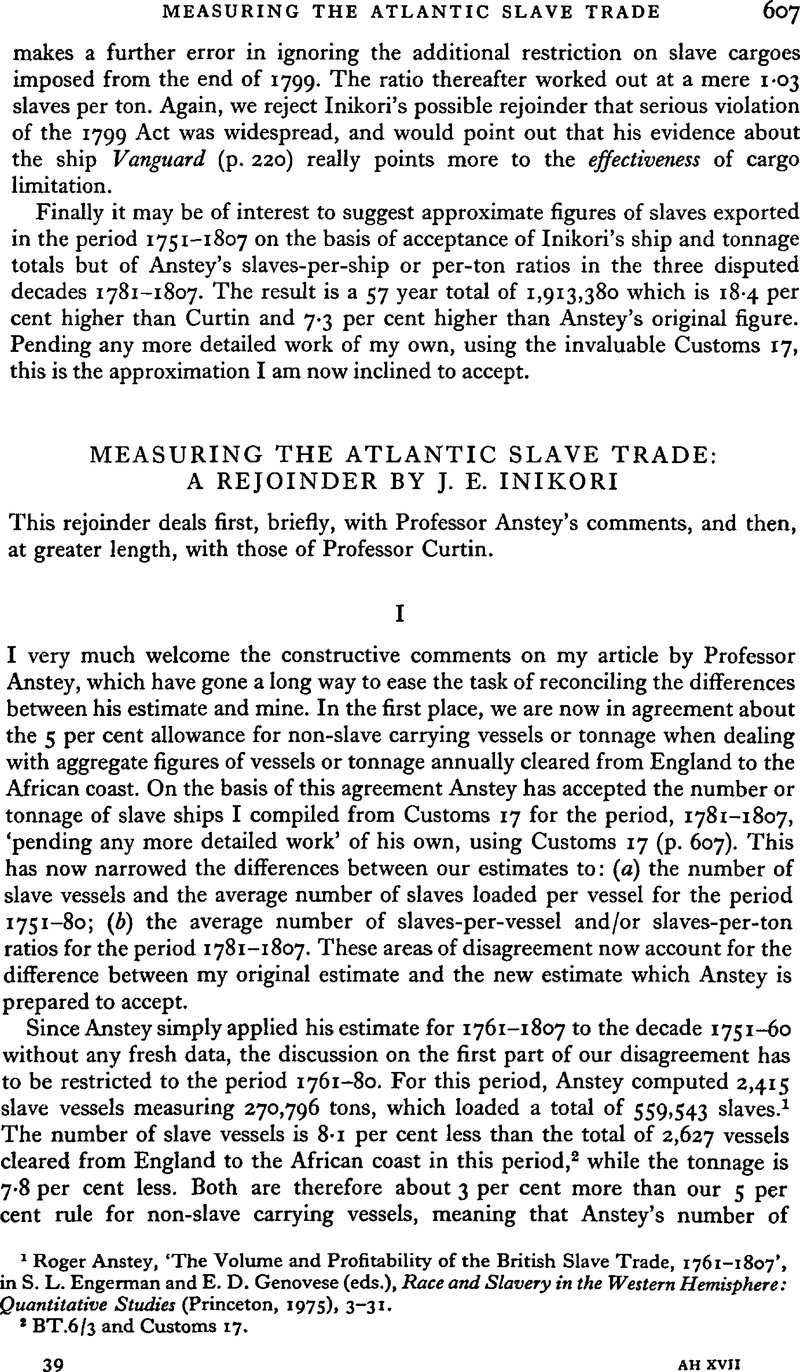Article contents
Measuring the Atlantic Slave Trade: A Rejoinder
Published online by Cambridge University Press: 22 January 2009
Abstract

- Type
- Discussion
- Information
- Copyright
- Copyright © Cambridge University Press 1976
References
1 Anstey, Roger, ‘The Volume and Profitability of the British Slave Trade, 1761–1807’, in Engerman, S. L. and Genovese, E. D. (eds.), Race and Slavery in the Western Hemisphere: Quantitative Studies (Princeton, 1975), 3–31.Google Scholar
2 BT.6/3 and Customs 17.
3 Inikori, , ‘Measuring the Atlantic Slave Trade’, 211, Table 2.Google Scholar
4 Ibid. 213.
5 Ibid.
6 Ibid. 208.
7 Ibid. 208, 220–1.
8 Anstey, Roger, The Atlantic Slave Trade and British Abolition, 1760–1810 (London, 1975), 11–12, n. 31.CrossRefGoogle Scholar
9 Mathematical Social Science Board Seminar on the Economics of the Atlantic Slave Trade, 20–22 Aug. 1975, at Colby College, Waterville, Maine, U.S.A.
10 Curtin, , Census, p. xviii.Google Scholar
11 Inikori, , ‘Measuring the Atlantic Slave Trade’, 197.Google Scholar
12 Curtin, , Census, 87.Google Scholar
13 Ibid. 86.
14 Inikori, , ‘Measuring the Atlantic Slave Trade’, 197.Google Scholar
15 In fact, many of these estimates were based on official data.
16 Curtin, , Census, 149.Google Scholar
17 Ibid.
18 Ibid. 146–9, and Table 42, p. 148.
19 Inikori, , ‘Measuring the Atlantic Slave Trade’, 205–6.Google Scholar
20 Vansina, Jan, Kingdoms of the Savanna (Madison, 1966), 53Google Scholar. See also Birmingham, David, Trade and Conflict in Angola: The Mbundu and their neighbours under the influence of the Portuguese, 1483–1790 (Oxford, 1966), 25–6.Google Scholar
21 Curtin, , Census, 99.Google Scholar
22 Ibid. 135. Curtin does not state the source of his information. But it is probable that he based this conclusion on a table in Williams, Gomer, History of the Liverpool Privateers and Letters of Marque (London, 1897), 678Google Scholar, in which 1794, is left blank. This simply means that the author had no information for that year.
23 Customs 17/16, fo. 9.
24 Curtin, , Census, 48–9.Google Scholar
25 Ibid. 148, Table 42.
26 Ibid. 142, Table 41, column (5).
27 The ‘official values’ in Customs 3 and 17 were based on constant prices of commodities exported, which were established at the beginning of the eighteenth century.
28 Harris, J. R., The Copper King: A Biography of Thomas Williams of Llanidan (Liverpool, 1964), 11.Google Scholar
29 P.R.O., CO. 415/7, A. no. 172, pp. 12–13, Capt. Acland's Journal no. 2, Moç., 9 Oct. 1826, quoted by Alpers, Edward A., Ivory and Slaves in East Central Africa: Changing Patterns of International Trade to the later nineteenth century (London, 1975), 212.Google Scholar
30 British Parl. Papers, Accts & Papers, 1789, vol. 84, part IV, Supplement to no. 15, no. 3, Barbados.Google Scholar
31 d'Aubertueil, Michel René Hilliard, Considérations sur l'Etat Présent de la Colonie Française de Saint-Domingue (2 vols., Paris, 1776 and 1777).Google Scholar
32 Inikori, , ‘Measuring the Atlantic Slave Trade’, 204 and 221.Google Scholar
33 BT. 6/10, p. 83, Evidence of Fuller, James, 1788.Google Scholar
34 Inikori, , ‘Measuring the Atlantic Slave Trade’, 198.Google Scholar
35 Ibid. 199.
36 Curtin, , Census, 59.Google Scholar
37 Inikori, , ‘Measuring the Atlantic Slave Trade’, 202.Google Scholar
38 Ibid. 201–3.
39 Ibid. 200.
40 Ibid. 202, n. 23.
41 Ibid. 203.
42 Ibid. 203–4.
43 ‘Un tableau de la traite française en 1785 indique une importation de 34,045 noirs des côtes occidentales d'Afrique uniquement pour Saint-Domingue, sans en compter au moins 3 ou 4,000 expédiés des côtes de Mozambique. Nous savons que, pour 1787, l'introduction réelle a été de 31,171, et pour 1788, de 30,097. En 1789, écrit un auteur, “nos colonies exportent chaque année de la Guinée 36,500 nègres”’: Peytraud, L., L'Esclavage aux Antilles FrançAis avant 1789 d'aprés des documents inédits des Archives Coloniales, Thèse Présentée à la Faculté des Lettres de Paris (Paris, 1897), 139.Google Scholar
44 Inikori, , ‘Measuring the Atlantic Slave Trade’, 221.Google Scholar
45 Ibid. 204.
46 Ibid.
47 Toplin, Robert B., The Abolition of Slavery in Brazil (New York, 1972), 18.Google Scholar
48 Ibid. 21, Table 1. Toplin's source is the Relatorios of the Minister of Agriculture, Commerce, and Public Works.
49 Ibid. 20–1.
50 Curtin, P. D., ‘Epidemiology and the Slave Trade’, Political Science Quarterly, lxxxiii (1968), 214Google Scholar. This rate is given by Curtin as applicable to the period 1772–1873. I cited Curtin in my original paper, and do so now, because he is my source for this information.
51 Eltis, D., ‘The Direction and Fluctuation of the Trans-Atlantic Slave Trade 1821–43: A Revision of the 1845 Parliamentary Paper’, paper presented at the Mathematical Social Science Board Seminar on the Economics of the Slave Trade, at Colby College, Waterville, Maine, U.S.A., 20–22 Aug. 1975.Google Scholar
52 Curtin, , Census, 205.Google Scholar
53 Anstey, , The Atlantic Slave Trade, 38.Google Scholar
54 Eltis, , ‘Direction and Fluctuation of the Trans-Atlantic Slave Trade 1821–43’.Google Scholar
55 Daget, Serge, ‘La Repression Britannique sur les Négriers Français du Trafic Illégal: Quelques conditions générates ou spécifiques’, paper presented at the Mathematical Social Science Board Seminar on the Economics of the Slave Trade, at Colby College, Waterville, 20–22 Aug. 1975.Google Scholar
- 9
- Cited by




